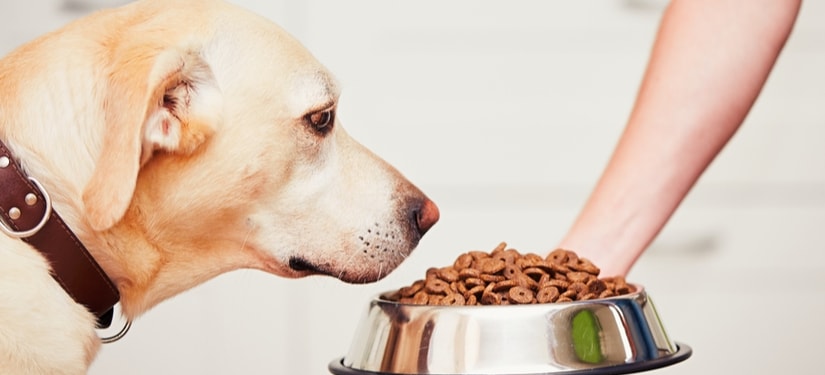What to Check Before Buying that Dog Food

Contents
If you check websites dedicated to dog health and wellness, most of them will showcase the good side of preparing raw food for your pup. They say that it’s more nutritionally adequate and you can control the sodium and carbohydrates by filling it in with more protein than grains.
But not all of us have the time in the world to prepare our own food, much more for our dog’s. Thus, most people rely on dog food because it’s more convenient. Whether wet or dry dog food, we expect them to provide the nutrients and Calories their pups need to survive.
However, contrary to what these pet food manufacturer’s say, not all dog food is equipped to give most, if not all, of the nutrients your pup needs to survive and go along with his daily activities. After all, they spend money on advertisers whose goal is to make you believe that their product is better than their competitors.
As a consumer and dog owner, you have a responsibility to ensure the health of your family, including your pet by being well-informed of the choices you have. To know if that dog food is best for your pet, here are things you should check:
In the ingredients list…
- Look for a meat source at the first three or four ingredients. Whether it’s chicken, lamb, or beef, the essential part of the list is where the meat comes from. Make sure that it does not have a “by-product” written beside it, as this would mean that the meat can come not just from the lean parts but also from the trimmings, feathers, intestines, or even tumors that were mixed with the meat itself.
- If it has grains, throw it out. Some dogs have adverse reactions to gluten that can be found in grains like corn and oats. Also, some experts agree that although they need carbohydrates, it must come from wholesome sources, that’s why most manufacturers use starchy vegetables like potatoes instead. This ingredient must not be found on the list, especially if the brand boasts that their product is grain-free.
- The shorter the list, the better. A short list means that very few if any, preservatives were added to the formula. Even better if the ingredients are written in names that you recognize or are familiar with.
Extra tip: Meat vs. Meal
Some ingredients you may find on the label may contain “chicken” and “chicken meal” at the same time. You need not fret as these two items are the same, at least in nature. The meal version of meat contains less water and moisture than the meat itself, making it a more concentrated version. This means that it has more protein and flavor than ordinary meat.
At the Guaranteed Analysis…
- Look for one that has adequate protein content. The recommended percentage of protein you should find in your pet food is determined by your dog’s age and activity. For puppies and pregnant dogs, it should at least be 28% as they need it for their growth and development. For fully grown dogs, their need is at least 18%. This number shoots up to 35% if he or she participates in high-performance activities such as hunting and racing. They need protein for tissue repair after all the wear and tear they experienced before, during, and after the performance. (For best puppy foods recommended by vets, check out this article)
- Fat should be there, but not too much. A maximum of 20% fat must be seen in each serving of the pet food-just enough to provide flavor to it. Fat is essential to maintain your pup’s healthy skin and lustrous fur coat and to absorb vitamins A, D, E, and K. Too much of this nutrient, however, can bring obesity especially to sedentary dogs. (For more tips on how to help your dog lose weight safely, click here)
Extra tip: Analysis Allowances
The “Guaranteed Analysis” portion is most likely tested in a laboratory than in a real-life setting because of ethical concerns. Thus, you must approach this label with caution, as they cannot provide exact figures-only estimates. Also, the analysis cannot be taken at face value if it’s canned food because the moisture content should be considered.
Check the label for…
- An indication that they follow the AAFCO guidelines. AAFCO or the Association of Animal Food Control Officials provides nutritional standards that are heeded by pet food manufacturers all over the state. While they do not have the authority to certify a manufacturer, having their guidelines followed is a seal for a consumer that their products are safe to consume and are nutritionally adequate for their pets.
- The manufacturing and “Best by” date. A manufacturing and “Best by” date that is ten or eleven months away means that the package was made just recently. Also, any dog food that can be kept for more than a year signifies that artificial preservatives are added to make it last longer. These can cause harm to your dog when consumed.
- Feeding guidelines. Only a handful of dog food manufacturers make formulas specifically for a breed. Most of them make ones that can be fed to a wide range of breeds, sizes, and ages. Feeding guidelines are there to instruct dog owners how to avoid giving a large-breed portion to a toy pup, and vice versa.
Extra tip: Feed-grade vs. Human-grade
Some brands use these health claims to lure consumers in. Human-grade means that food quality safety and sanitation standards for humans are used and followed to manufacture the food, while feed-grade is a subsidized version of it (sub-standard meat could come from anywhere and be added then labelled “meat by-products” in the ingredients list). When looking for dog food, opt for one that has “Human-grade”-if you can eat it then your pup can do so as well. Be careful though, because “Human-grade” does not mean that prohibited human foods are now allowed.
Finally! You have chosen a specific brand! Now, all you need to do is look for…
- A good, airtight packaging.For dry dog food, the package should have no tears, holes, or any open spaces that could let air out of the bag and decrease the dog food’s freshness. For canned food, inspect for rusts and damaged cans, as this would mean that the oxygen has come inside the can, bringing airborne bacteria with it.
While buying dog food, the possible question that might always arise is, can dogs eat cinnamon and other non-toxic dog food in any quantity? Well, for safety purposes, it is prudent to check the indicated amount on the container that is used to pack your dog’s food.
Employing these tips might cost you more time at the dog food aisle, not to mention the stares from other shoppers. But if you believe that your four-legged friend should be given only the best, then the sacrifice of finding the appropriate dog food for him or her is worth it.
Be reminded, however, that it is still your dog who has the final say. Always check for reactions from him or her that would entail that the dog food does not suit his body and lifestyle.
